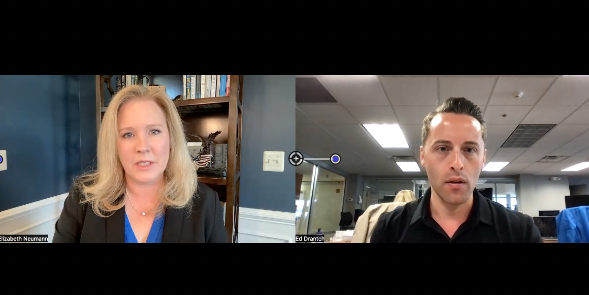BUFFALO, N.Y. (WKBW) — Over the past several weeks, we've been talking about red flag laws in New York State and across the country. All of this came to light because the suspect in the Buffalo Tops shooting, was known to police but never actually "red flagged."
That allowed him legal access to guns.
Even after strengthening red flag laws statewide, the 7 News I-Team has discovered legal loopholes — that omit many people from the chain of notification — when someone is red flagged. That includes the highest levels of state government.
Saturday, May 14 was chaotic. Police were calling for crowd control while also trying to figure out what happened at Tops on Jefferson Avenue. Many family members were outside the supermarket, trying to get any information they could.
It took two minutes and three seconds for the suspected shooter to carry out the rampage, before police say he surrendered.

The suspect was legally able to buy guns, despite the fact that he was known to police. They say he made threats in school about murder/suicide. An evaluation by mental health experts yielded no cause for concern.
But a year later, all of this has become a nightmare for the ten victims' families. That incldues Pam Pritchett. Her mother, Pearl Young, was killed in the shooting at Tops.
"At the end of the day, if they have a questionable history, then there's no reason they should have access to firearms," Pritchett said.
RED FLAG CASES IN WESTERN NEW YORK
The State has since strengthened red flag laws. That allows more people to file Extreme Risk Protection Orders (ERPOs) in court. An ERPO is what's used as a red flag.
Between January 1, 2021 and June 28, 2022, the 7 News I-Team has discovered:
- at least 34 Western New Yorkers have had their guns taken away between Chautauqua, Erie, Genesee, Niagara and Wyoming counties.
- 21 orders have been issued in Erie County alone, by judges who've found there is a substantial risk of imminent threat to themselves or another person.
New York ERPO List by Sean Mickey on Scribd
NO ACTUAL RED FLAG LIST
But the I-Team has learned there's no actual "red flag list." Even if there was one, the highest levels of state government would have have no idea who is even on that list.
That includes the Governor, the County Executive and in some cases, the District Attorney.
The I-Team asked Erie County District Attorney John Flynn why that isn't happening now.

"Well because there's no law requiring it to happen right now," Flynn said.
Under the expanded law, New York State Police tell the I-Team,
"the court is required to notify State Police, any other law enforcement agency with jurisdiction,
the local permit licensing officer and the Division of Criminal Justice Services."
VULNERABILITIES IN THE SYSTEM?
This required notification omits many levels of authority — like those people you would think, would be in the know. Experts say this poses quite the problem.
"Anytime there is a gap in information from those who need to know, it's a huge problem," Elizabeth Neumann said. Neumann is the former Department of Homeland Security Assistant Secretary for Counter-terrorism. She served under former Presidents George W. Bush and Donald Trump.
"It creates vulnerabilities, it creates opportunities for sadly individuals like the Buffalo attacker to get through the system," Neumann said.
When you don't have a higher level of coordination and continuity between government agencies, Neumann said, "there's no way for a system to work if you don't have that interconnectedness."

This homeland security expert takes it a step further.
"I think there's a compelling case to make an employer or a school principal has a need to know if an individual has been determined by a judge to pose a risk to themselves or to them others. It's great the weapons been taken from them, but there are also other ways people can cause harm," Neumann said.
Flynn says local law enforcement would know about who's had a red flag order issued against them. They are the ones to go in and remove guns after the judge's order. Gun dealers would also see that information if this person tried to buy a gun. Police would also see if that person is red flagged if they're pulled over.
He also said he agrees, there should be one level of notification for law enforcement, schools and all government entities to work together.
Still, without top down notification, Pritchett feels we're at risk.
"I do believe there needs to be connection on every level, in every part of government," Pritchett said. "I think that what happens is we don't have that connection and then people slip through. There definitely needs to be a lot more checks and balances. I think this is pivotal — not only in Western New York— but pivotal in our nation because we are talking not only about gun violence, but we are also talking about white supremacy at the same time. Those two things have made what happened in Buffalo extremely unique."
Filing an Extreme Risk Protection Order is not easy. It involves a lengthy application process and lot of evidence. There's a hearing and a judge looks to see if there is an imminent risk. These orders last one year. They are sealed after expiration and not available to the public.
In Allegany, Cattaraugus and Orleans counties, the I-Team has learned there have been zero ERPOs issued.
—
TRANSPARENCY MATTERS TO US
We started asking questions, for context, about red flag laws and the number of people 'red flagged' after what happened in Buffalo on May 14. From there, we asked about the process and how someone would find out if another was red flagged. When we learned there is no actual list, we realized many people in power don't know who poses a danger and went forward with this story.






